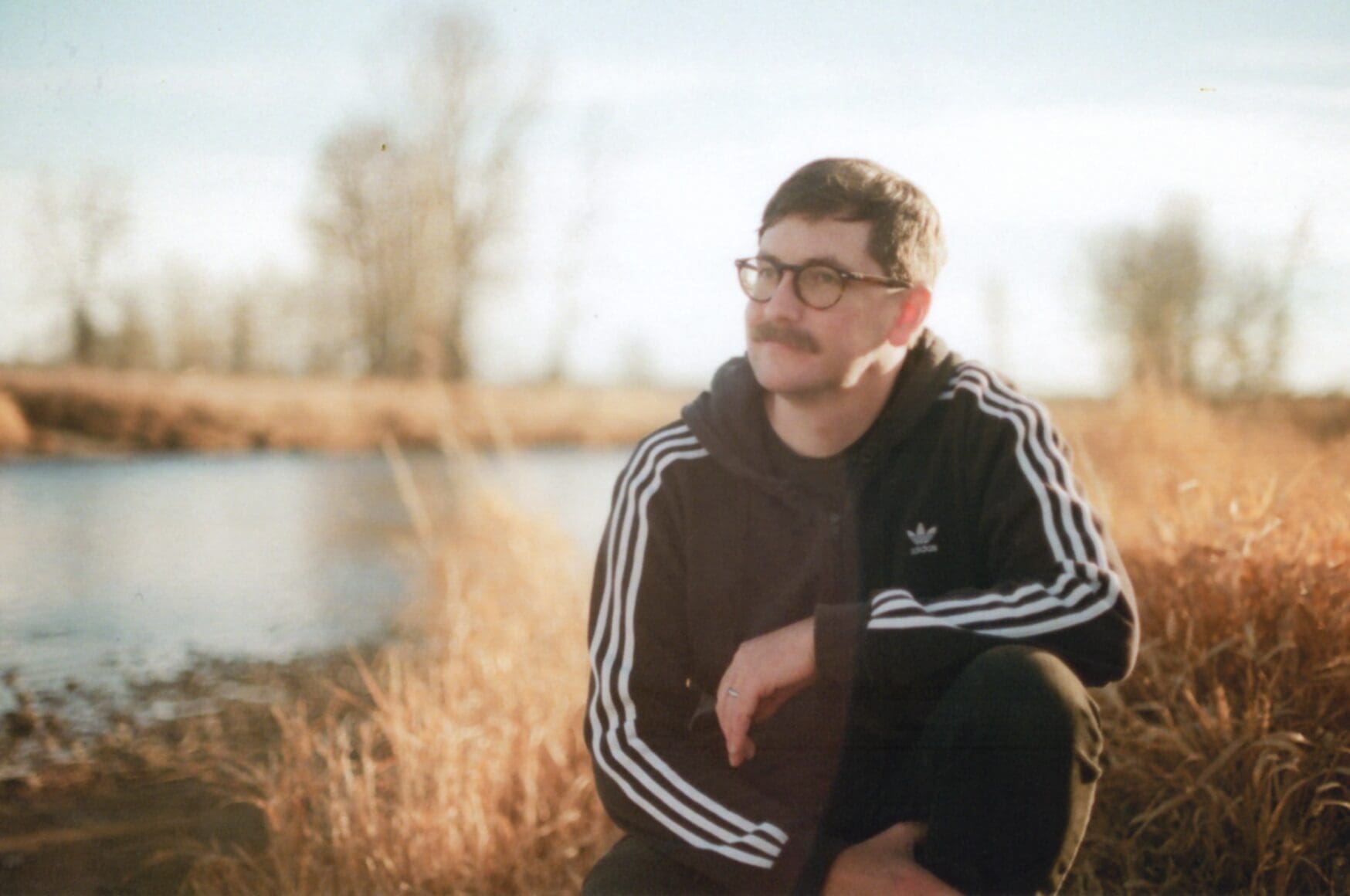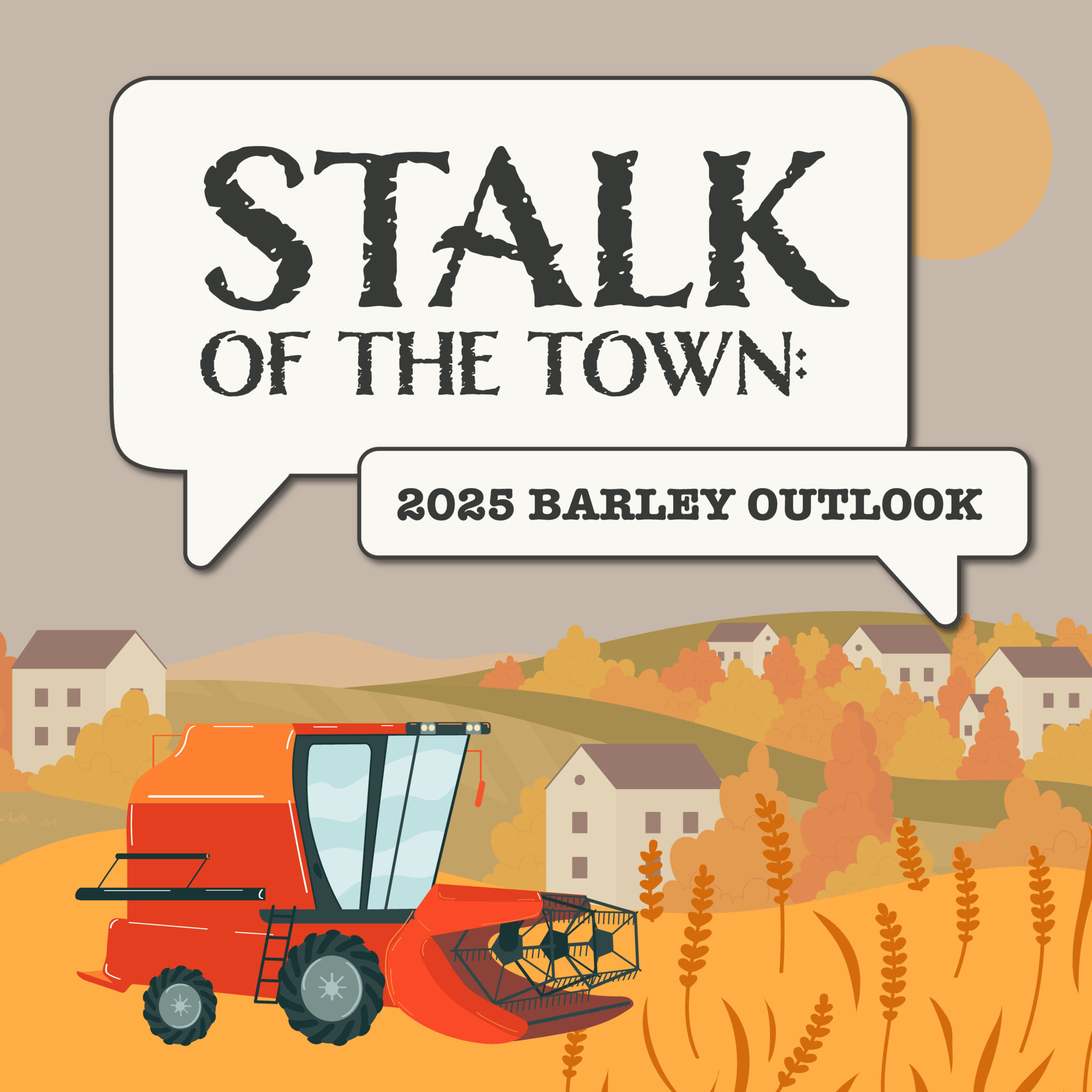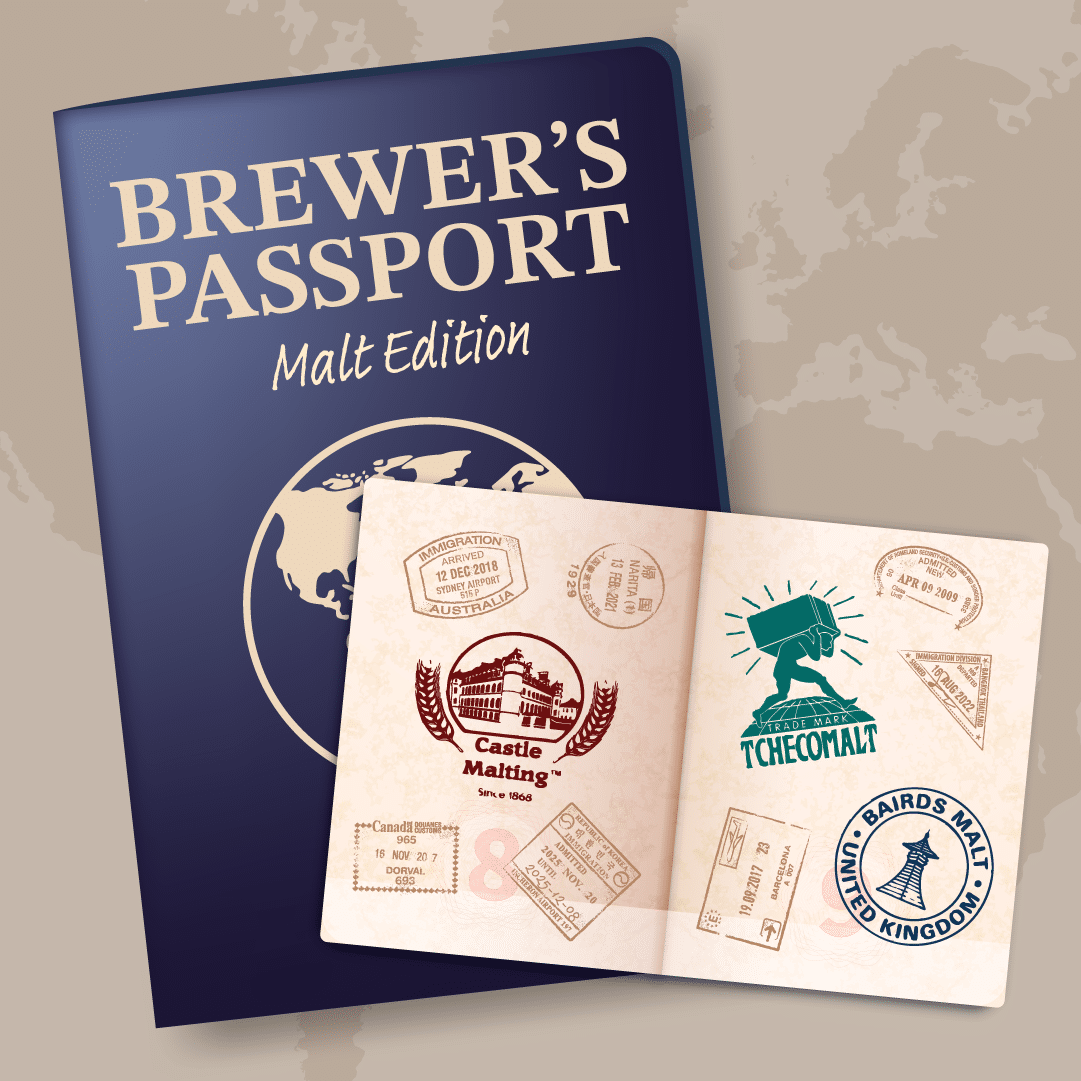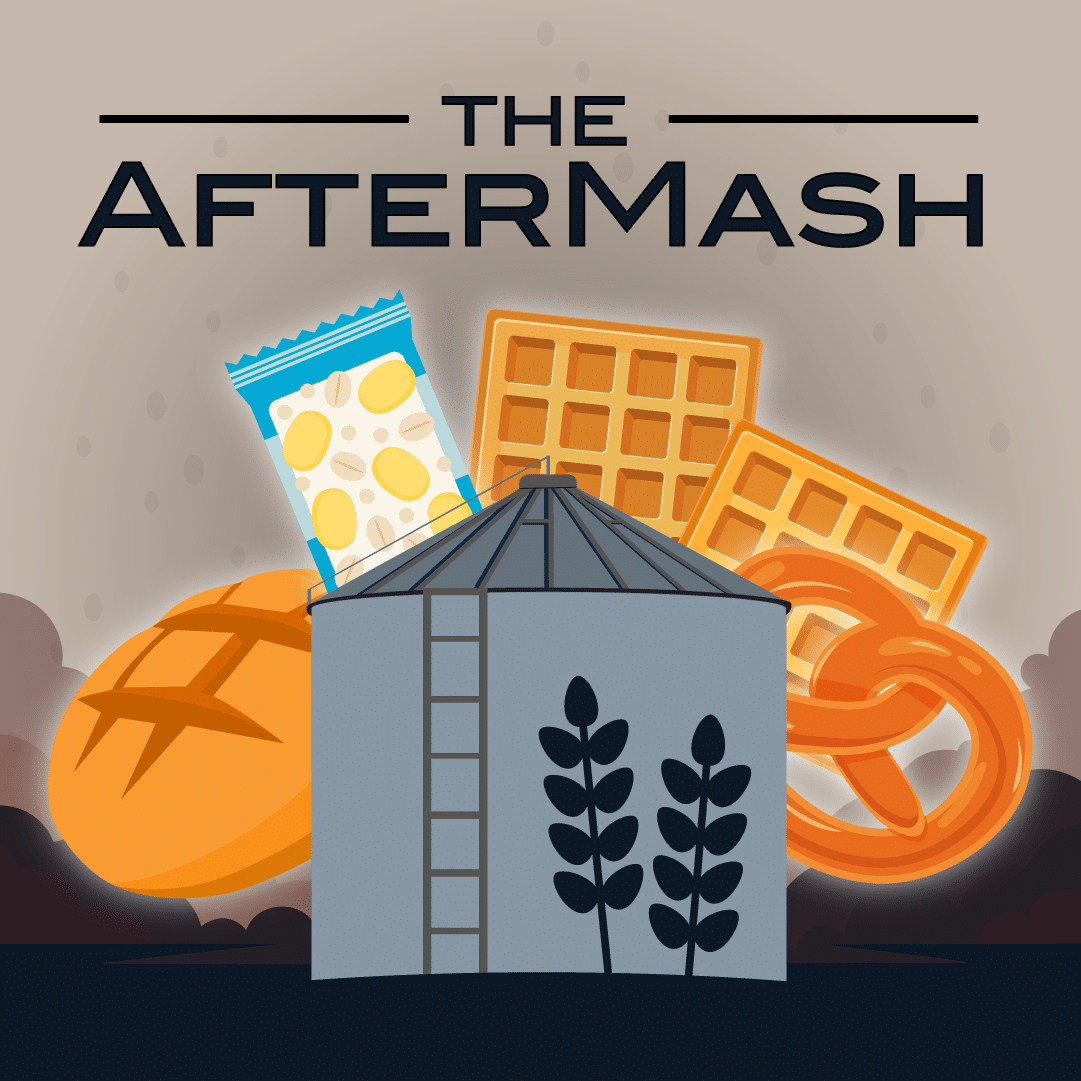
Jonathan Warwick
 Jonathan Warwick is a Project Engineer with United Malt based in Calgary, Alberta and holds an M.Eng in Chemical Engineering from Loughborough University. Before moving to Canada in 2017, he started his Malting career with Bairds Malt in 2014 and has been passionate about sustainable malt, and its products, ever since.
Jonathan Warwick is a Project Engineer with United Malt based in Calgary, Alberta and holds an M.Eng in Chemical Engineering from Loughborough University. Before moving to Canada in 2017, he started his Malting career with Bairds Malt in 2014 and has been passionate about sustainable malt, and its products, ever since.MORE EPISODES
SEASON 4, EPISODE 8: LOVE YOUR ENVIRON-MALT
HEATHER JERRED – TERRITORY MANAGER, COUNTRY MALT GROUP
CHEYENNE WEISHAAR – SALES REPRESENTATIVE, COUNTRY MALT GROUP
CJ PENZONE – TERRITORY MANAGER, COUNTRY MALT GROUP
GUEST:
JONATHAN WARWICK – PROJECT ENGINEER, CANADA MALTING CO.
- How to minimize environmental impact through ordering more efficiently
- Where you can participate in the Malt Bag Recycling Program
- What is Canada Malting Co.’s Membrane Bioreactor initiative and how much water it saves
- What are the benefits of the Combined Heat and Power (CHP) plants
- How the new CleanO2 project works
Transcript - Love Your Environ-Malt
EPISODE S.4, E.8
[LOVE YOUR ENVIRON-MALT]
Heather (00:09):
Welcome back to another episode of The BrewDeck Podcast. My name is Heather and I’m joined today by CJ and Cheyenne. Hi y’all.
Cheyenne (00:17):
How’s it going?
CJ (00:19):
Howdy.
Heather (00:21):
Well, Happy Earth Month, everyone. So this week we are going to be talking to Jonathan Warwick, project engineer for Canada Malting, and he’s going to be telling us all about our sustainability efforts at United Malt with our malting facilities across Canada and the US. Make sure you hop over and listen to last year’s Earth Month episode titled, Save the Earth: It’s the Only Planet with Beer. That’s season three, episode seven. In that episode, we spoke to Hopworks Urban Brewery and to Tin Whistle Brewing about their sustainability efforts. Hey CJ, could you let us know some ways that our customers can minimize their environmental impact through some efficient ordering?
CJ (01:03):
Yeah. Some great ways to do this would be picking up your orders directly from the warehouse if you’re nearby. For customers in the Chicago, Illinois, San Diego, California, Vancouver, Washington, Asheville, North Carolina, or Tampa, Florida, they can utilize our hot truck program. This includes direct deliveries from our warehouse to your facility and eliminates traditional shipping methods, which may include multiple trucks and distribution centers in between. You can fill your pallet entirely rather than ordering partial pallets.
Heather (01:38):
That’s really important.
CJ (01:40):
And lastly, we’re set up to be a one-stop shop. So through us you can easily add hops, yeast, fruit puree, and more to the top of your malt pallet. This reduces packaging and the amount of shipments you have heading to your facility.
Heather (01:54):
Oh, that’s awesome. And Cheyenne, you’re in the Washington area. Can you let us know about the malt bag recycling programs that we’ve got going on?
Cheyenne (02:03):
Yeah, definitely. This is actually a really cool program that we have going on. I get asked by a lot of customers about it. Basically, Country Malt Group and Great Western Malting created a malt bag recycling program that was geared to help brewers and distillers recycle their plastic waste. Like you mentioned, it was started at the Vancouver, Washington distribution center in 2022. We’ve extended this program to our Chicago, Illinois warehouse as well. So, all number five polypropylene plastic malt bags can be recycled and they’re upcycled to be made into future plastic items. In Vancouver, Washington alone, since the program was started in 2022, we’ve recycled 20,000 pounds of plastic, which is 66,700 malt bags. And if you’re interested in more information, you can reach out to your local rep.
Heather (02:47):
Oh, that’s awesome. If you want any more information on CMG and United Malts’ sustainability efforts, please go over to our blog, which is on the CMG website. Let’s jump into talking to Jonathan. And we are joined now by Jonathan Warwick, project engineer from Canada Malting. Welcome, Jonathan. Thank you for joining us today.
Jonathan (03:07):
Hi there. How’s it going? I’m good, thank you.
Heather (03:09):
Doing pretty good. Can you tell us a little bit about yourself and your role with Canada Malting?
Jonathan (03:16):
Yeah, sure. So, my job title is project engineer. It’s a little bit of a broad description, but essentially I work for the engineering department in our Canada operations, but we look at all of UMG in North America, including Great Western Malting. And in encompassing that job role, I basically look at project development. So scoping out potential projects in the future, doing feasibility studies, feasibility calculations for a lot of these projects, in addition to, obviously, running and managing the projects. So that’s sort of my main focus, but I also sort of take on other responsibilities within the business with utilities and emissions reporting and all of these things that are becoming more and more part of operating a business in 2022, or 2023 even.
Heather (04:07):
And how long have you been with Canada Malting?
Jonathan (04:08):
I’ve been with Canada Malting full time about six years. Prior to that I worked for Bairds Malt, which is our sister company out of the UK, and I worked for them for about two and a half years. So within the organization as a whole, about eight years, six of which has been in Canada.
Heather (04:28):
Awesome. So, we’re going to jump into it. Obviously, we’re doing this week’s podcast on sustainability, and we really wanted to talk about all the sustainability efforts that UMG, especially Canada Malting, have going on. So, can you touch a little bit for us on the MBR project?
Jonathan (04:50):
Yeah, absolutely. So the MBR, MBR stands for a membrane bioreactor. It sounds fancy, but it’s a generally all-encompassing sort of term for the style of wastewater treatment plant that we put in in our Calgary facility in approximately 2013. So, essentially what are we doing is in the malting processes, we use a large amount of water. I’ve mentioned here that specifically our water on the Calgary site, and a lot of our other sites actually, is drawn almost entirely from underwater aquifers. So we have process wells we treat our water from, and we use that in our malting process to obviously hydrate the barley, clean the barley during the steeping process.
(05:34)
But off the back of that, obviously barley’s a seed that comes off the field. It’s covered in dirt, dust, all that lovely stuff. So, the steeping process is kind of like a cleaning process for the grain. And as a consequence, obviously, all that waste water that we drain out of the steep tank is full of what we call BOD, or biological oxygen demand, or material that will be consumed by our microorganisms in the water system. So what the MBR does essentially, it receives all of that wastewater that we produce. It goes through a number of tanks, which we call, fancily, bioreactors, but realistically they’re just very large tanks. And inside these tanks we have a cocktail of microorganisms that basically break down and digest the organic material in the wastewater in sort of a clean way. And then we take all of that water out of the bioreactors and we run it through an membrane, which is where the M comes in.
(06:41)
And that filters off the organisms themselves. We recycle that back into the process. We waste a portion every day, but essentially as the organisms multiply and reproduce, we need to, obviously, keep them [inaudible 00:06:53] back. So, we use that as a sludge. We produce a sludge off of that, which is then sent for composting. So, the long story short is we ended up with a much cleaner wastewater than we would otherwise. Essentially we get 97% reduction in the organic matter in the water, and on our Calgary site, all of our water is returned back to the water table via the river. So, essentially we are right by the river where we’re located. All of our fresh water gets drawn up through the wells, will be used in a process. Nothing gets added other than the natural sort of dirt and dust and grain from the grain. We strip that back in a sort of low carbon way possible, and then we return it back to the river, basically returning all the water that we already took.
Heather (07:42):
I heard people talk about it like, “Oh, we clean our water to the point that it could be put back into the Bow River.” I’m like, “Cool.”
Jonathan (07:51):
Yes, exactly. And obviously, we have a whole suite of online testing that happens automatically. So we know exactly what we’re sending the river in any given amount of time, and if there’s any sort of deviation from our acceptable bounds, then it kicks off a valve and it all gets diverted away from the river so we’re not getting our wrists slapped.
Heather (08:10):
Not polluting. Awesome.
Jonathan (08:14):
Yeah. And just to give you a sense of scale of the operation, essentially we’re processing approximately 2,000 meters cubed of water a day. So, quite a fair bit of water is going through the wastewater treatment plant at any given time.
CJ (08:30):
And how much water is this saving per day?
Jonathan (08:37):
The wastewater treatment plant wouldn’t necessarily save water. Essentially, it reduces a lot of the pressure that we put on the municipal wastewater treatment plant. Essentially, if we didn’t have an MBR, we would have two options. One, we would either have a different style of wastewater treatment plant, which would probably emit more carbon on a per cube of water basis. Or we send it to the municipal system, which is essentially almost identical in many ways to what we run, except, obviously, we are quite dilute or relatively dilute to a lot of the wastewater that they would send or they would normally receive. So, it’s not very energy efficient in order to do so if you look at the global sort of picture of things. I mentioned about the emissions from the wastewater being low. Essentially, if you look at the carbon lifecycle of what we’re doing here is we’re growing barley, which comes out of the ground. That barley is absorbing carbon from the atmosphere and going into the structures of the grain, the starch in the grain, the husk, everything. It’s built out of carbon, right?
CJ (09:49):
Mm-hmm.
Jonathan (09:51):
When we steep the grain, some amount of that gets stripped off and washed off and it will be broken back down to a gaseous form. With our bioreactor system, it’s what we call an aerated system, a higher oxygen system. And basically all of that carbon gets returned back to CO2, which is good. Essentially, we haven’t left a [inaudible 00:10:14] impact on the planet. An alternative system that might be anaerobic or low oxygen environment may convert those carbon chemicals to methane, which has a much higher global warming potential than what carbon dioxide has. So, you would essentially have a net. But [inaudible 00:10:32] on your emissions, whereas us, when we’re doing an aerated oxygenated system, is it’s net zero essentially to what the plant is doing.
Heather (10:40):
Cool.
Jonathan (10:42):
Sorry. I went off in the weeds there.
Heather (10:43):
No, it’s good. Like I said, I’ve seen it, I’ve been there. I used to work on the Canada Malting plant, so I’ve seen it, but I really couldn’t fully explain. I watched the YouTube videos on it and I cannot explain how that works. So, thank you.
Jonathan (10:57):
Did you get to look through the microscope? Do you see any of the bugs going around?
Heather (11:01):
No. Now, I feel like I’ve missed something-
Jonathan (11:05):
Oh, that’s the coolest part.
Heather (11:06):
Okay. Well, I’m going to be back in August, so we have a date to go look at this.
Jonathan (11:13):
Absolutely. Yeah. I mean, as I mentioned, all the work gets basically done by these microorganisms and essentially it’s not like a monoculture of yeast in a beer fermentation because it’s a [inaudible 00:11:30] of creatures and they all have the different lifespans and relative complexities of life. And if you look in a sample under the microscope, you just see amazing little worlds down there. There’s tardigrades, these little six-legged bears climbing around, chewing on bits of barley. Nematodes, which are predatory eels that go around and hunt and eat the other organisms. It’s like a little mini jungle. It’s kind of cool.
Heather (11:54):
That is insane.
Cheyenne (11:56):
That’s very, very cool. Well, switching gears a little bit, can you tell us about the combined heat and power plant, and specifically what are the benefits to that project?
Jonathan (12:07):
Yeah. So, this is a bit more of a recent project. I think we got it started the very first time in December of 2021. So we’ve been running it, I don’t know, just over a year flat out at this point. 14, 15, 16 months, I believe. So CHP is another acronym that we use, but it just means combined heat and power plant. Combined in the fact that it generates heat and it generates power. So we are essentially bringing in natural gas, we burn it in our generator, so it’s a reciprocating generator for those that care about these things. But essentially a big, big engine and it fires off natural gas, which is pretty clean burning. And most of that energy goes into the production of electricity. So, we actually produce approximately 85% of our own power on the Calgary site now on the back of this combined heat and power plant that we put in.
(13:11)
So we generate a lot of electricity, but anytime that you’re generating electricity, there are energy losses in the system. So, that’s where the heat comes in. The whole system is essentially jacketed. The whole engine and generator are jacketed in a glycol system. And we pull off the excess heat that’s generated from the combustion and we pick that up and we send it off into radiators that are actually located in our malt kiln. So there’s actually a really large amount of heat energy that would otherwise be left on the table from electricity generation like this that we capture.
(13:49)
And because we’re a malting operation, we’re always in demand of heat, and essentially we have a demand for that heat 24/7. So we always have a demand for power and we always have demand for heat. And the best efficiency for a CHP system is to run it at full-on power 100% of the time, which is essentially what we do. So, we’re very efficient in that way. And basically we can bump the efficiency of the system up from 43%, 44% up to 88%, 89%. So, we’re capturing a lot of heat that way and making use of it. And all of that heat is essentially offsetting what we would otherwise have to normally burn through our malt kiln. So, it’s a straight reduction for us in our other heat use. Yeah, we-
Cheyenne (14:39):
Wow, that’s really interesting.
Jonathan (14:43):
Yeah, yeah, it’s a fun little project. Yeah, we were supported by it from the Government of Canada through their Low Carbon Economy Fund. So, essentially that was a grant program that was run by the federal government here in Canada on the basis of reducing carbon intensity across the economy. And so although it’s a natural gas burning generator, essentially it reduces our net carbon intensity of our process by approximately 18%. So, you’re probably wondering how or why. Well, the main part of it is our geography here in Calgary. We’re, obviously, located in Alberta. Alberta has been a little bit slower in terms of cleaning up their electricity grid. So, there’s still a relatively large amount of carbon and higher emitting sources of power generation on the grid. So by getting a modern cogen system, or combined heat and power system, going for our site, we actually generate power that’s a lot cleaner than what we buy from the grid. And additionally, obviously, all of those offsets that we get from capturing that heat and using our kiln further reduces, essentially, our footprint in terms of carbon.
Heather (16:08):
That’s crazy.
Jonathan (16:09):
Yeah. So, there’s other things that we’ve done that actually further sort of improve the efficiency and the cleanliness of the system. So we actually put in an SCR, which is a catalytic reactor in the exhaust plenum for the generator. So whenever you burn a fuel source, obviously carbon dioxide is the main sort of emission that you get. But one of the other ones you get is nitrogen dioxide or other oxides of nitrogen. We call them NOx or NO2. NO2 is specifically nitrogen dioxide and NOx is the class of chemicals. That’s another sort of greenhouse gas that gets emitted when you burn fuel. So, our SCR actually scrubs the vast majority of that out of our exhaust and we actually clean up our exhaust much cleaner than we could otherwise. So, that’s one other thing that we did.
(17:08)
And then the other one was we actually added secondary heat capture loop. When we’re talking cogen, we have high-grade heat, which is… We use these turns to make us sound a bit more fancy than it is. But high-grade heat means pretty hot water, like 60, 70 degrees Celsius above. And then we have low-grade heat, which is warm water or… Yeah, pretty hot water, which [inaudible 00:17:34] 30, 40, 50 degrees. Usually it’s difficult for us to use what we call low-grade heat, but actually we found a pretty good use for it on the site. And we can capture it and send it into a small unit, which essentially preheats sort of our combustion air for our main kiln heaters. And that’s essentially just another energy gain that we get above that 88, 89% efficiency. Yeah, pretty good.
Cheyenne (18:06):
When did this project start or come into effect, sorry? The combined heat and power plant.
Jonathan (18:14):
Yeah. So, I’d say that’s a good question. So, I think we originally started planning… I mean, CHP plants, I’ll say, are pretty much a no-brainer for most malting businesses. It’s finding the specific size and the specific location that makes them work from an economy and efficiency point of view. But we’ve been looking at these casually for honestly 5 or 10 years now. I started looking a little bit more seriously in about 2017, 2018, I believe. Looking at shopping around, seeing what’s available, what was the right fit from us from an engineering and installation perspective. And I think the project started in late 2019 and sort of ran through. And we got it operational in December of 2021 was when it just turned on for the first time. And so we’ve been running it pretty much flat out [inaudible 00:19:18] 2022. And yeah, it’s been doing fantastic for us. Really, really good.
Cheyenne (19:23):
Oh, that’s awesome.
Heather (19:25):
All right. I’m going to do another pivot because we have at least one more thing to talk about with Canada Malting because this was actually just released about our CO2 capture project and working with CleanO2 in our CO2 capture. CarbinX, I believe, is what it’s called.
Jonathan (19:45):
Yeah, I think that’s the name of their proprietary technology or reactor they use. But yeah, CleanO2 is the name of the company. They are a Calgary-based company here that essentially their main business is soap production. They make domestic soap, hand soap. And they actually have a pretty novel technology where they have a reactor, which you sort of bolt onto the flue stack of a boiler or a HVAC unit. And it actually captures the carbon dioxide out of the flue and converts into potassium carbonate. So, essentially we’re taking carbon that would otherwise be emitted into the atmosphere. We’re turning it into a stable solid, a mineral that has practical uses. Specifically, obviously, they’re a soap company, so what they use it for is they use it as sort of a lather enhancer or lathering agent in their soap. And yeah, that’s kind of what we got.
(20:53)
In terms of the grand scale of our operations, it’s what we call a pilot scale. It’s pretty small. It doesn’t make a large, large dent in our operations, but it’s proving out the technology. And the intention there is that once we’ve proven that it works and it’s effective and there’s a good business partner there in CleanO2, now we can scale this technology up for more kilns, for our cogen. Anything that essentially has a flue stack, we can pull it out. So, I think their pilot scale unit is about six to eight metric tons of carbon a year. This is what they reduce or what they sequester out of the emissions. And there’s some additional gains in the fact that the chemical reaction that happens between the carbon dioxide as it generates the pearl ash actually use exothermic. So we can get a little bit of extra heat out of the system, which we can pump back in preheating water, preheating air if you’re putting it in an HVAC unit.
(21:58)
So we put one of these in actually very recently at our Calgary site, probably about three months ago, I think, is when they started it. And yeah, they’ve been pulling off some pearl ash, getting it dialed in, getting it all operating as efficiently as they can. And yeah, it’s kind of a neat little project. It’s a pretty mutually beneficial arrangement for us because, obviously, they’re looking for industrial partners to trial this. And obviously, this is something that we’re very much interested in. And as we look at a long road, 2050 commitments, trying to get to net zero and things like that, programs such as carbon sequestering are going to be a part of that puzzle that we put together. So, it’s great that it’s not a hypothetical on a spreadsheet. It’s a real physical unit you can slap and kiss and whatever you want to do to-
Heather (23:00):
It’s an actual bar of soap.
Jonathan (23:02):
Yeah. Yeah, exactly.
Heather (23:04):
And for anybody listening, I do believe we are going to have some of the soap at our booth at CBC, so make sure to come by and get some of that and see how this all turned out. That’s really, really, really cool. One last thing while we’ve got you, and we’re just going to monopolize your big brain here for a little bit longer, can you speak to the Optisteep that was recently kind of became up and running in our Great Western plant in Idaho?
Jonathan (23:33):
Yeah, absolutely. So the Optisteep system is a four-scale system that we put in at our [inaudible 00:23:43] maltings in Idaho, as you mentioned. And essentially, it’s a little bit of a novel technology. Essentially, it’s using a continuous cleaning and scouring of the water that we use during steeping to reduce the overall need for water. So we’re going to go back to school a little bit, malting school, if you indulge me.
Heather (24:10):
Definitely.
Jonathan (24:11):
Essentially, whenever we steep barley for malting, if you just take all your barley and you put it in a tank and you just dump a load of water on it and you let it soak, it’ll take some amount of water up. But ultimately what will happen is essentially it will start to drown. Barley, although it doesn’t look like it, is a living organism. It has to respire, so it needs oxygen to do so. So what we typically do is, obviously, we aerate the water. So we inject oxygen into the bottom of the tanks, get it bubbling, get it moving, keep the oxygen count in the water high, and so that the grain can continue to respire.
(24:53)
But even with that, if you leave it underwater for extended period of time, 24 hours, 48 hours without break, essentially you can’t really delay the fact that it will drown. It will just get waterlogged, it will not behave the way that you want to, and you’ll make some of the worst malt that you’ve ever seen anywhere. So what the traditional way and what malting has been doing for, [inaudible 00:25:18] want to say hundreds of years, thousands of years, in order to get around that, essentially we do multiple immersions. So we fill a tank, fill it with water, let it soak for… Depends on the barley, depends on what recipe, 6 to 12 hours. And then we drain the water and we actually let it sit for another 6 to 12 hours as we sort of continue to aerate it so it’s not underwater for that period of time, and then we refill it with water.
(25:44)
What you can’t do, however, is reuse that same water from the first immersion in the second immersion. There are compounds and elements to that water once you’ve drained it off, that actually if you reintroduce it back to the barley will inhibit the germination of the grain. So what we do is we do multiple immersions, which means we end up using more water. For a site like Calgary where we actually have a very readily healthy supply of water in the form of the aquifers and a good outlet in terms of the MBR, this has a relatively minor impact on our overall operation or the overall impact of our operation. In other geographies, obviously water scarcity and the relative impact of our wastewater is different. So this is why we’re looking at technologies like Optisteep. Now, Optisteep kind of throws all of the traditional malting knowledge out the window because essentially the water that we are introducing to the barley is continuously drawn off the bottom of the tank.
(26:54)
We put it through the Optisteep system, which essentially has some absorption elements to it, sort of pull off and absorb a lot of the organic material I was talking about when we discussed the MBR. But additionally, we actually introduce ozone into the water. And so ozone is O3, it’s a compound of three oxygen atoms all bonded together. It’s very highly reactive and it’s very unstable in atmospheric conditions. So what happens is when you inject ozone into the water, is it will essentially bind to anything that’s vaguely reactive or organic in nature and will just rip it apart. On a vernacular level, it would just rip molecules apart. So, it actually reduces a lot of that BOD on a molecular level. The really nice thing about ozone is that it actually just… Essentially, once it does so, it’s oxygen. It’s not… What’s the word? Polluting the atmosphere.
(28:07)
Essentially, it breaks down and back into O2, which is oxygen in our atmosphere, and it’s completely inert from the point that it gets basically reintroduced back to the tank. It’s gone. It’s done its job, it’s ripped apart the contaminants in the water, and it’s cleaned it all up. So what that means is that that water that we reintroduce back into the tank can be reused, which it traditionally isn’t able to do so. And all of that means that we only really have to do a single immersion.
(28:40)
Historically, they used to do three to four immersions back in hundreds of years ago when they had very sort of poor barley and poor technology. We didn’t have the aeration systems that we have today. That brought down to three immersions as sort of the varieties got better and the technology got better. And as breeding programs came along in the last few hundred years, we’ve got it down to two immersions, which is sort of the standard. But that’s been otherwise the limit of our capability in terms of what the barley varieties can handle. With the Optisteep system, we’ve got it down to a single immersion. So, now we’re essentially reducing [inaudible 00:29:19] consumption by 40%, which it’s a step change that was otherwise not considered even possible nowhere even 20, 30 years ago.
Heather (29:27):
That’s huge.
Jonathan (29:29):
Yeah. Yeah. There’s additional benefits. Obviously, as you introduce the ozone, you’re ripping apart all those compounds. That means that the relative BOD of your wastewater that you’re sending to your wastewater treating plant is lower. So your biological loading that you’re sending into those systems is lower, which, obviously, is less work that those systems have to do. And there’s additionally some benefits to the grain itself. So as you oxygenate, essentially, the water, this hyperoxidation, the grain, as it’s respiring, is getting juiced, is just getting a big old jolt of oxygen to the system. So, it’s leaving the steep tank way more vigorous than would otherwise be possible with just simple air injection.
(30:22)
And what it means is it gets our malt germination started sooner, which means that essentially it’s able to germinate at lower moistures at a more vigorous rate. Lower moistures means that we’re sending less moisture to the kiln, which means the kilns are working less hard in order to kiln off that moisture, which means that we’re not burning as much electricity, not burning as much gas [inaudible 00:30:49] to. So it’s got this really sort of multifaceted benefit to the system that’s really interesting to us and it represents essentially a sea change in what’s possible in malting technology.
Heather (31:07):
So cool.
Cheyenne (31:08):
I know. We hear about these [inaudible 00:31:13]-
Jonathan (31:12):
Yeah, sorry. Yeah.
Heather (31:14):
No. Do not be sorry. All of us were like, “Okay, we kind of know little bits and pieces of what these things do, but the breakdown of it, that’s freaking awesome. Thank you so much, Jonathan. I really, really appreciate it.
Jonathan (31:26):
No problem.
Heather (31:27):
I feel mildly smarter, but I don’t know if I could answer any questions on this. No quizzes later. Well, awesome. I think that is all we have for you. I really, really appreciate you coming on today and just explaining all these projects. I think it’s really, really important for people to know the efforts that UMG as a whole is putting into our sustainability.
Jonathan (31:55):
Yeah, absolutely. I mean, I talk in generalities a little bit here, if you don’t mind.
Heather (32:01):
Go for it.
Jonathan (32:01):
Obviously, these are some of the larger projects that we’ve been doing in the last few years to 10 years ago in terms of the MBR. And the things that we’re trying out, some of them are more proven than others, some are a bit more experimental than others, as you can appreciate. As we get into the age that we’re in in 2023 and these net zero targets that we’re shooting for in 2050, that the world has to shoot for in 2050, all projects are essentially about emissions reductions. I cannot think of a single one that we’ve got on our pipeline, be it in a year’s time, in 20 years’ time that isn’t some way about reducing the impact that we have on our planet.
(32:56)
It becomes our singular focus really at this point, is we’re trying to make our systems more efficient, more clean, more beneficial to the planet. Malting in general is an agriculture process. So we’re usually just returning to the ground what came from the ground, which is pretty nice. If you look at the overall carbon lifecycle, what happens to barley as it turns into malt, into beer, gets consumed, respire, it’s all returning back into the same system. But there are energy inputs, obviously. And our focus at UMG, really, moving forward, is to improve and push the boundaries of what can be done within the malting realm. Yeah, it’s an opportunity. We don’t get to talk about it very much, but essentially that’s really in the engineering department here, in my role, it’s really a singular focus if you wanted to sum it up. But yeah.
Cheyenne (33:59):
Oh, that’s awesome.
Heather (34:01):
So we’ll stay tuned and see what’s to come, I suppose.
Jonathan (34:06):
Stay tuned. Exactly. Yes.
Heather (34:07):
Stay tuned. Awesome. Awesome. Well, thank you everyone for joining us. Great big thank you to Jonathan for coming on and telling us all about the sustainability efforts at CMG. It is almost time for CBC. We are going to be there next month. I will be there. So will CJ and Cheyenne. And we can’t wait. If you want some information on stuff that we’ll have going on at CBC, head over to our website, that’s countrymalt.com/cbc23, to get a preview of our booth and the beers that we’re going to have on tap there. And we will see you in 20 days.









